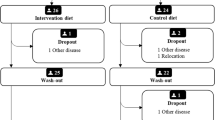Abstract
Dietary fish oil supplements have been shown to have benefits in rheumatoid arthritis (RA), other inflammatory diseases, and in cardiovascular disease. As with any medical advice, variability will exist with regard to adherence and consequent biochemical or pharmacophysiologic effects. The aim was to explore the utility of plasma phospholipid EPA as a measure of n−3 PUFA intake and response to standardized therapeutic advice given in an outpatient or office practice setting, to increase dietary n−3 PUFA, including a fish oil supplement. Patients with early RA were given verbal and written advice to alter their dietary n−3 PUFA intake, including ingestion of 20 mL of bottled fish oil on juice daily. The advice included instructions to increase n−3 PUFA and to avoid foods rich in n−6 PUFA. Every 3 mon, blood samples were obtained for analysis of plasma phospholipid FA. Plasma phospholipid EPA was used as the primary index of n−3 PUFA intake. A diverse response was seen, with about one-third of patients achieving a substantial elevation of plasma phospholipid EPA over the 12-mon study period. A third had little change, with the remainder achieving intermediate levels. Data obtained longitudinally from individual patients indicated that substantial elevations of EPA (>5% total plasma phospholipid FA) could be maintained for more than 3 yr. Plasma phospholipid EPA is a convenient measure of adherence to advice to take a dietary n−3 PUFA-rich fish oil supplement. This measure may prove a useful adjunct to intention to treat analyses in determining the effect of dietary fish oil supplements on long-term outcomes in arthritis and other chronic inflammatory diseases. It may also provide a guide to the effectiveness of therapeutic and preventive messages designed to increase n−3 PUFA intake.
Similar content being viewed by others
Abbreviations
- AA:
-
arachidonic acid
- HUFA:
-
highly unsaturated FA
- IL:
-
interleukin
- RA:
-
rheumatoid arthritis
- TNF:
-
tumor necrosis factor
References
James, M.J., and Cleland, L.G. (1997) Dietary n−3 FA and Therapy for Rheumatoid Arthritis, Semin. Arthritis Rheum. 27, 85–97.
Belluzzi, A., Brignola, C., Campieri, M., Pera, A., Boschi, S., and Miglioli, M. (1996) Effect of an Enteric-Coated Fish-Oil Preparation on Relapses in Crohn's Disease, N. Engl. J. Med. 334, 1557–1560.
Donadio, J.V. (2001) The Emerging Role of Omega-3 Polyunsaturated FA in the Management of Patients with IgA Nephropathy, J. Renal Nutr. 11, 122–128.
O'Keefe, J.H., Jr., and Harris, W.S. (2000) From Inuit to Implementation: Omega-3 FA Come of Age, Mayo Clin. Proc. 75, 607–614.
Siscovick, D.S., Raghunathan, T.E., King, I., Weinmann, S., Wicklund, K.G., Albright, J., Boybjerg, V., Arbogast, P., Smith, H., Kushi, L.H., et al. (1995) Dietary Intake and Cell Membrane Levels of Long-Chain n−3 Polyunsaturated FA and the Risk of Cardiac Arrest, J. Am. Med. Assoc. 274, 1363–1367.
Arnett, F.C., Edworthy, S.M., Bloch, D.A., McShane, D.J., Fries, J.F., Cooper, N.S., Healey, L.A., Kaplan, S.R., Liang, M.H., and Luthra, H.S. (1988) The American Rheumatism Association 1987 Revised Criteria for the Classification of Rheumatoid Arthritis, Arthritis Rheum. 31, 315–324.
Pincus, T., Swearingen, C., and Wolfe, F. (1999) Toward a Multidimensional Health Assessment Questionnaire (MDHAQ): Assessment of Advanced Activities of Daily Living and Psychological Status in the Patient-Friendly Health Assessment Questionnaire Format, Arthritis Rheum. 42, 2220–2230.
Cleland, L.G., James, M.J., Neumann, M.A., D'Angelo, M., and Gibson, R.A. (1992) Linoleate Inhibits EPA Incorporation from Dietary Fish Oil Supplements in Human Subjects, Am. J. Clin. Nutr. 55, 395–399.
Mantzioris, E., James, M.J., Gibson, R.A., and Cleland, L.G. (1994) Dietary Substitution with an α-Linolenic Acid-Rich Vegetable Oil Increases Eicosapentaenoic Acid Concentrations in Tissues, Am. J. Clin. Nutr. 59, 1304–1309.
Lands, W.E.M., Libelt, B., Morris, A., Kramer, N.C., Prewitt, T.E., Bowen, P., Schmeisser, D., Davidson, M.H., and Burns, J.H. (1992) Maintenance of Lower Proportions of (n−6) Eicosanoid Precursors in Phospholipids of Human Plasma in Response to Added Dietary (n−3) FA, Biochim. Biophys. Acta 1180, 147–162.
Caughey, G.E., Mantzioris, E., Gibson, R.A., Cleland, L.G., and James, M.J. (1996) The Effect on Human Tumor Necrosis Factor α and Interleukin-1β Production of Diets Enriched in n−3 FA from Vegetable Oil or Fish Oil, Am. J. Clin. Nutr. 63,116–122.
Dinarello, C.A. (1995) Controlling the Production of Interleukin-1 and Tumor Necrosis Factor in Disease, Nutrition 11 (5 Suppl.), 695–697.
Infliximab Prescribing Information, MIMS Online, 1 February 2003–30 April, 2003.
Author information
Authors and Affiliations
Corresponding author
About this article
Cite this article
Cleland, L.G., Proudman, S.M., Hall, C. et al. A biomarker of n−3 compliance in patients taking fish oil for rheumatoid arthritis. Lipids 38, 419–424 (2003). https://doi.org/10.1007/s11745-003-1078-9
Received:
Accepted:
Issue Date:
DOI: https://doi.org/10.1007/s11745-003-1078-9




